
Alexander Heinle
Alex is a marketer at Zavvy. On this blog, he mainly shares insights gained from discussions with selected experts and from helping our customers set up and improve their onboarding or learning programs.

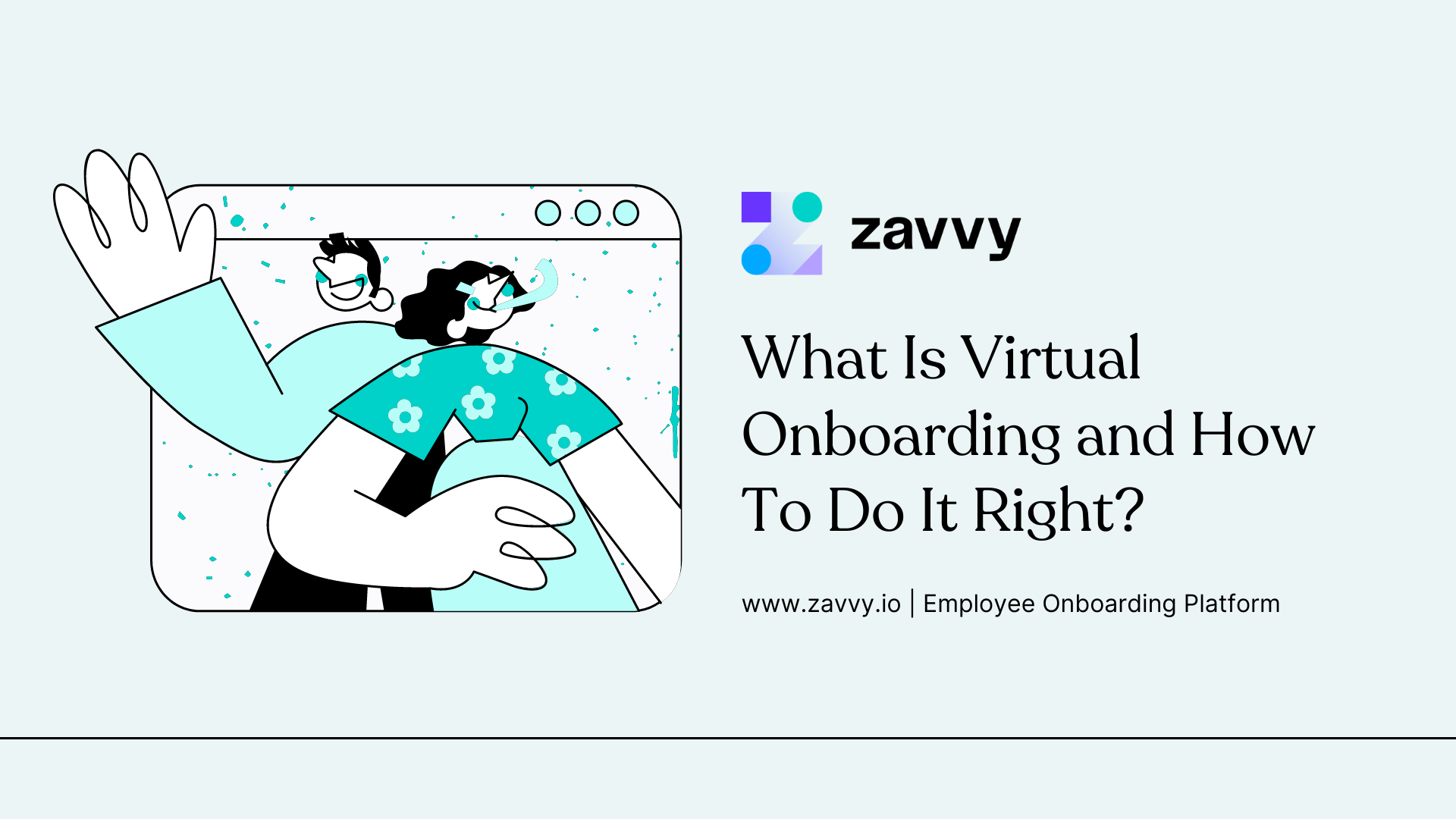
Your first impression is the last.
As much as this stands true for people, it applies to companies too.
Whether they launch a product or welcome new hires, the impression and impact should be top-notch.
Research from BambooHR revealed: 49 percent of employees who went through effective onboarding started contributing to their team within the first week.
And as we breathe and live everything online today, the need for a systematic and seamless virtual onboarding process elevates even further.
An ideal onboarding helps the employees kickstart their role and draws a clear vision for the next three days, three weeks, or three years they will spend with the organization.
The onboarding process intends nothing but to lay down a robust foundation for the relationship between the company and the employee. As a rule of thumb, the stronger the onboarding, the longer the relationship pans out.
However, since the pandemic's start, HR managers, recruiters, and founders are still having difficulties changing the gears from offline setup to online onboarding.
Together with our curators, we have created a library of actionable digital marketing resources. Personalized to your team's needs.
Virtual onboarding uses technology to facilitate the integration of new employees into a remote team. Organizations use virtual or remote onboarding initiatives to make remote employees feel welcomed to a new organization and reach productivity sooner.
It's a crucial time for both the employer and the employee, as it sets the tone for the rest of their working relationship.
While in-person onboarding is an excellent way to foster a warm welcome and help employees feel appreciated, it is only part of the equation - whether your company is remote-first or not.
By combining insightful videos, pre-recorded messages from senior executives, and a comprehensive online learning path, companies can ensure that remote workers feel like valued members of the team from day one.
It's a different feeling when you are around the new joiner in person, to welcome them to their desk, show them the cafeteria, and introduce them to their colleagues. But when you're executing all of these steps online, you can't expect things to fall in place so quickly.
Things will feel significantly less personal and humane when people merely meet over the screen.
They wouldn't be able to catch the watercooler conversations that would've taken place if they were in a physical office. When meaningful or casual conversations do happen online between meetings, they happen consciously.
But most of the time, they don't happen at all.

In this tweet by Kunal Shah, founder of the Indian unicorn Cred, he discusses the challenges of remote work.
Naturally, the virtual onboarding process runs on similar principles. The design of your induction journey should be so engaging that the new colleagues know what's coming next at all times.
HR managers may find this need to make constant efforts challenging.
One of the ways to get some control over this is by automating the virtual onboarding process with the help of software that offers end-to-end solutions. We will explore this part later in detail.
Although video conferencing applications may have connected the world in the best possible way, we still have a long way to go about understanding human emotions through screens.
It's tough to gauge people's body language, gestures, or expressions on video calls and more challenging to figure out if they interpreted you correctly.
Unlike the offline setup where the newcomers could clearly understand their roles and company from their managers and peers, virtual onboarding may not offer them that clarity if one of the steps doesn't go well.
During an offline onboarding process, we understood the different shades of the person as they approached various tasks throughout the day. Sometimes, when they were not confident enough to jell around, we would witness the heartwarming encouragement provided by their colleagues.
Through those close interactions, people experienced emotions and created memories. Adding to that, new employees would always bring extra energy and positivity to the table. It's hard to replicate their passion and enthusiasm in the virtual setup with their peers.
Lack of proficiency in specific technical tools is one of the biggest challenges of remote onboarding.
The employee entering the organization may never have used video conferencing, management, CRM tools, or standard tools offered by their new organization. Therefore, the gap will be prominent, which you can eliminate with clear documentation and explanation about the software to the new joiner.
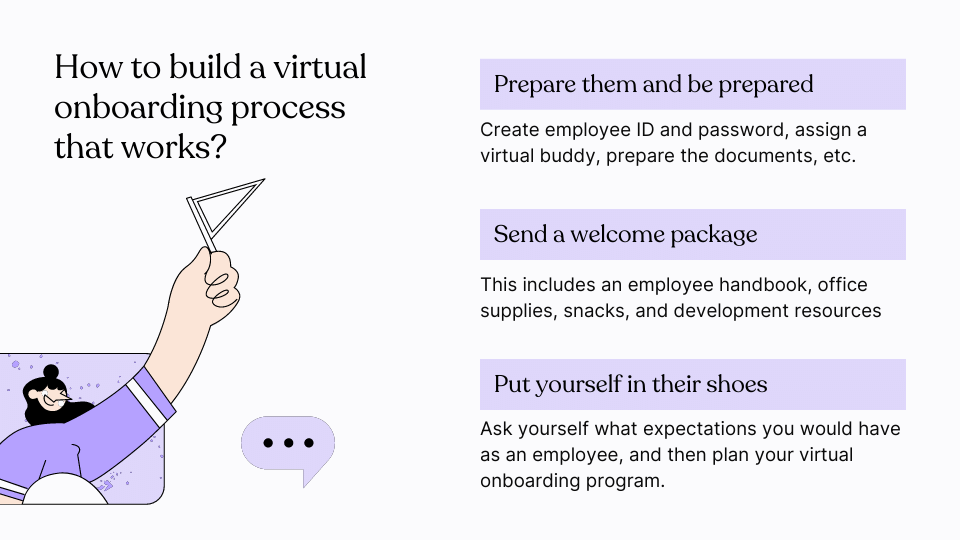
The virtual onboarding process should be as smooth and seamless as possible. New hires are likely to experience a mixture of excitement and anxiety on their first day, so it's essential to make this experience as positive as possible.
You may fail to plan, but planning never fails you.
It's best to create excitement about the first day, even before that day arrives. This is what we call preboarding step. So, how do you prepare for the big event?
Send them a welcome email before their first day. Through this communication, you can convey the initial steps you want them to take and share a rough idea of their day one.
Apart from this, you can also ask if they need anything or have any concerns before their starting day.
Keep them informed if they'd be having any special introductory calls with the C-suite executives, vice presidents, heads of departments, etc. This will help them prepare better and, as a result, rock their day one.
Proper preboarding is a topic by itself, but it's also your chance to really stand out.
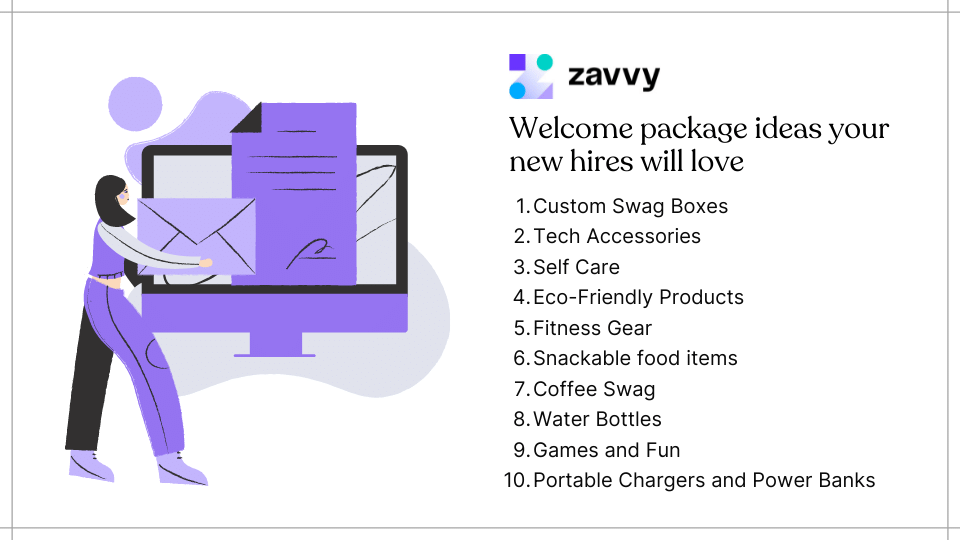
Who doesn't love gifts?
And even better when it's a thoughtfully crafted welcome package from your new employer.
It's a great chance to delight new employees - and motivate them to post a snap on Linkedin. Hands down, a welcome package has to be a part of your virtual onboarding process.
What could you stuff in those packages? No hard and fast rule.
As a rule of thumb, think of things that are
To get started, here are a few things that would make for a great welcome package:
This should contain the most important things you want them to know before starting their tasks, such as:
These and many more basic yet crucial details can find a place in this handbook.
Undoubtedly, this would be the most loved element of the welcome package. You can tie up with a service agency that offers customized snack boxes per your instructions or add a gift card to a food delivery app.
Some examples of these resources are books, courses, memberships, conference tickets, or simply anything they want to learn more about. Although they may love snacks and other gifts better, this part of the welcome package will lead them to become better professionals and individuals.
We've written extensive welcome gift ideas, which you can explore more here Explore some more exciting welcome package ideas.
Sometimes, it's much easier to find answers if we put ourselves in the shoes of a person we are trying to help.
Here, that person is your employee, and the problem statement is about building an impactful virtual onboarding process for them. So, ask yourself:
And after the first day, reflect on:
To help you out on planning the onboarding program, you can refer to our 30-60-90-day onboarding plan that meticulously breaks down the steps a new hire should take in their first, second, and third month of starting the new job.
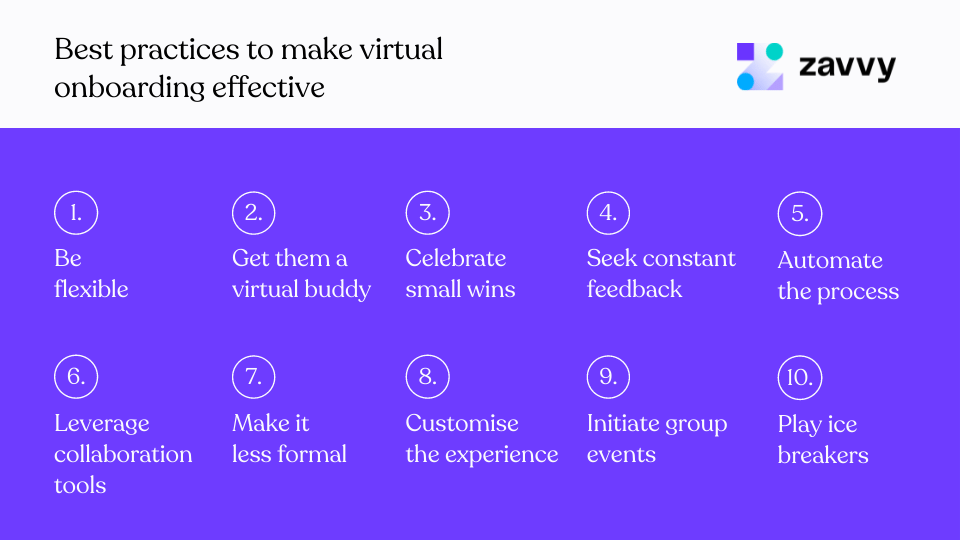
"Employee expectations are changing, and we will need to define productivity much more broadly — inclusive of collaboration, learning, and wellbeing to drive career advancement for every worker, including frontline and knowledge workers, as well as for new graduates and those who are in the workforce today. All this needs to be done with flexibility in when, where, and how people work." - Satya Nadella, CEO at Microsoft
Being flexible is probably the most significant learning that stands out in the past two years for hiring and employee management.
It's a great exercise to offer a planned and organized onboarding process to your new employees, but at the same time, it's also essential to give them a much-needed breathing space in between the tasks.
Let them know they can operate things at their pace and reach out to you if they find something too stressful. This doesn't mean you can't use deadlines — just do so consciously where they are needed the most.
Being flexible with your new joiners is one of the best ways to get a more qualitative outcome instead of the quantitative one. Remember, the process should prioritize learning, not results.
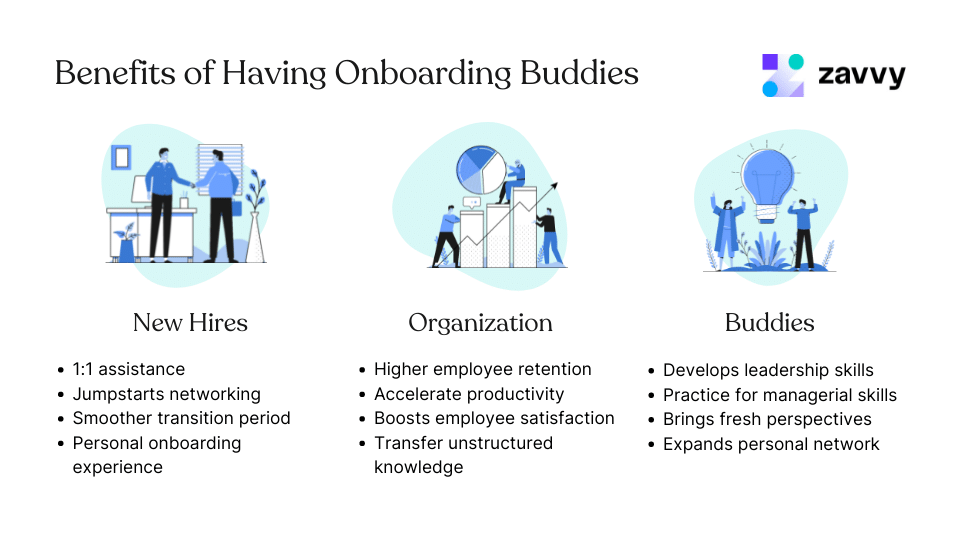
Despite sharing lengthy documentation and resources with the new employee, their curiosity will pique as they'll dig deeper into their role, and they'll have further questions coming up now and then. Asking the manager each and every time may get a little awkward; this is where their virtual buddy comes in.
So, what should a buddy look like?
1) Sufficient knowledge about the new hire's role
2) Strong job performance history
3) Capacity to assist the new hire
How does this buddy help the new employee?
Having a buddy helps a great deal. Here's everything you need to know about running an onboarding buddy program at your company - including free checklists.
When starting with a new organization, most employees are passionate about their new role and strive to put in more than expected.
Another side of this scenario also includes them being anxious and doubtful about whether they are good enough when meeting their colleagues and mentors at the job. To help them pass this feeling, you can assign them easy tasks and set smaller milestones to achieve as the starter.
For example, suppose they are sales professionals. In that case, you can mutually decide the target for the first week is to book one meeting with a prospect instead of choosing something unrealistic and eventually frustrating.
They will automatically be confident and inspired to surpass these numbers if they achieve that target. Apart from performance targets, you can also encourage them to engage in more informal activities, like having a virtual coffee with a colleague every day. Or complete 25% of the training videos in the first week.
Companies may have extraordinary onboarding processes, but just a few ask for feedback which is quite alarming. For example, only 26% of new joiners recollect their employers seeking input on the hiring and onboarding.
As new hires are even more isolated when going through a virtual onboarding, there is no way around collecting feedback constantly.
It also gives employees the space to express the good and bad parts of the process that could be changed or altered. You can automate these check-ins (e.g., via surveys and scheduling meetings) using software solutions.
Some questions that could help HR get precise feedback:
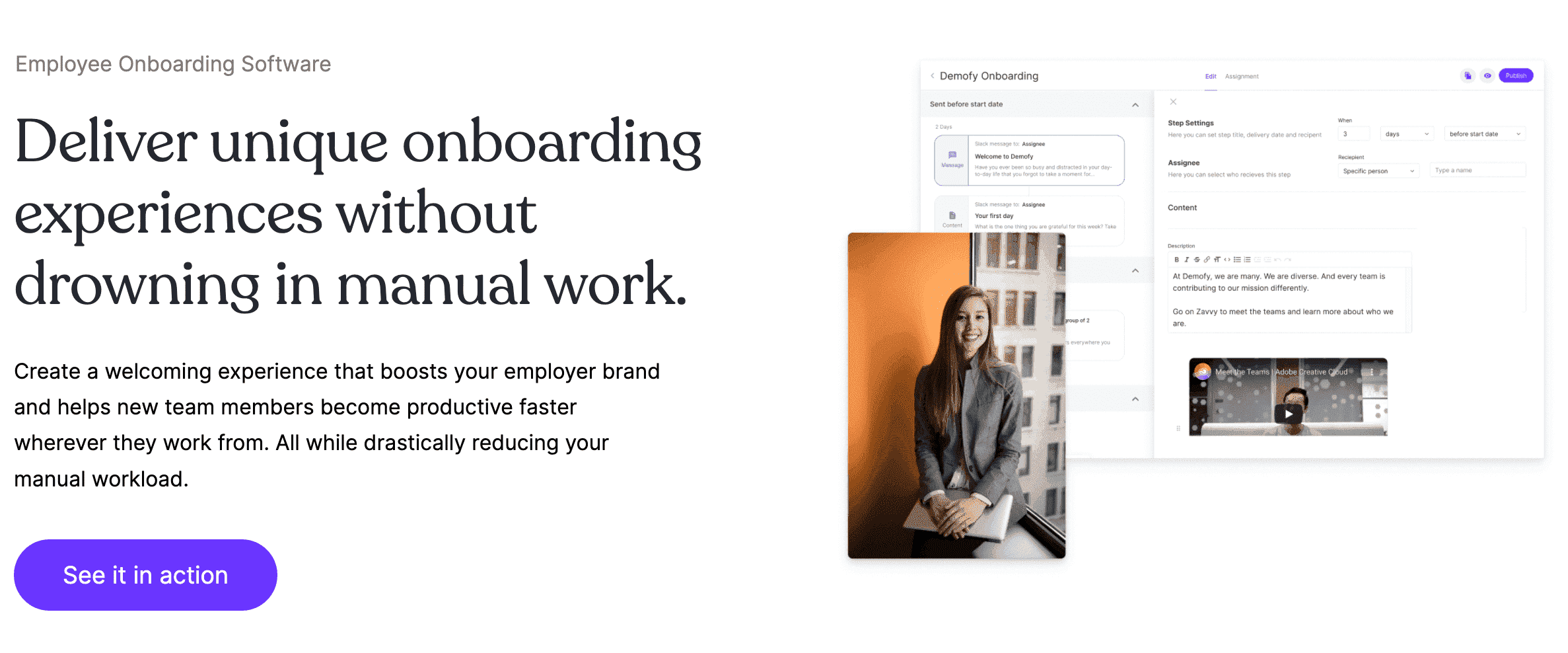
A virtual onboarding process could include multiple rounds of documentation, training, group interactions, 1:1 meeting with the new employee, orientation meetings, and administrative tasks.
As much as the new joiner needs a systematic approach to navigate this process, the same goes for HR teams.
In the interest of time and energy, it's a wise decision to automate the onboarding process with the help of software and tools available. It makes a massive difference to the HR managers of growing organizations who constantly juggle tons of tasks apart from onboarding.
Even dedicated onboarding managers should not spend big chunks of their time manually sending out repetitive emails, meeting invites, or introducing the same tools over and over again. Instead, modern People Ops teams are experience-driven and data-driven.
If you want to deliver an uncompromised virtual onboarding experience, make automation a non-negotiable part of the process. With automation, you set up smart systems once — say goodbye to last-minute messy work.
It also saves you the tedious process of repeating tasks every time you onboard a new employee. Adding to that, it is undoubtedly more efficient, timely, and consistent than the manual onboarding process. You can use the saved time to interact more with the new employee and form a stronger relationship with them right from their first day.
A good virtual onboarding process also integrates as deeply as possible into the workflow.
That means using tools like Slack, Asana, and Microsoft Teams. This is where the team spends most of their time blending in groups and connecting with their co-workers one-on-one on a personal level. Furthermore, sending messages via Slack is claimed to be 3x more effective than emails to complete a task.
To get them started with these communities, you can schedule activities like:
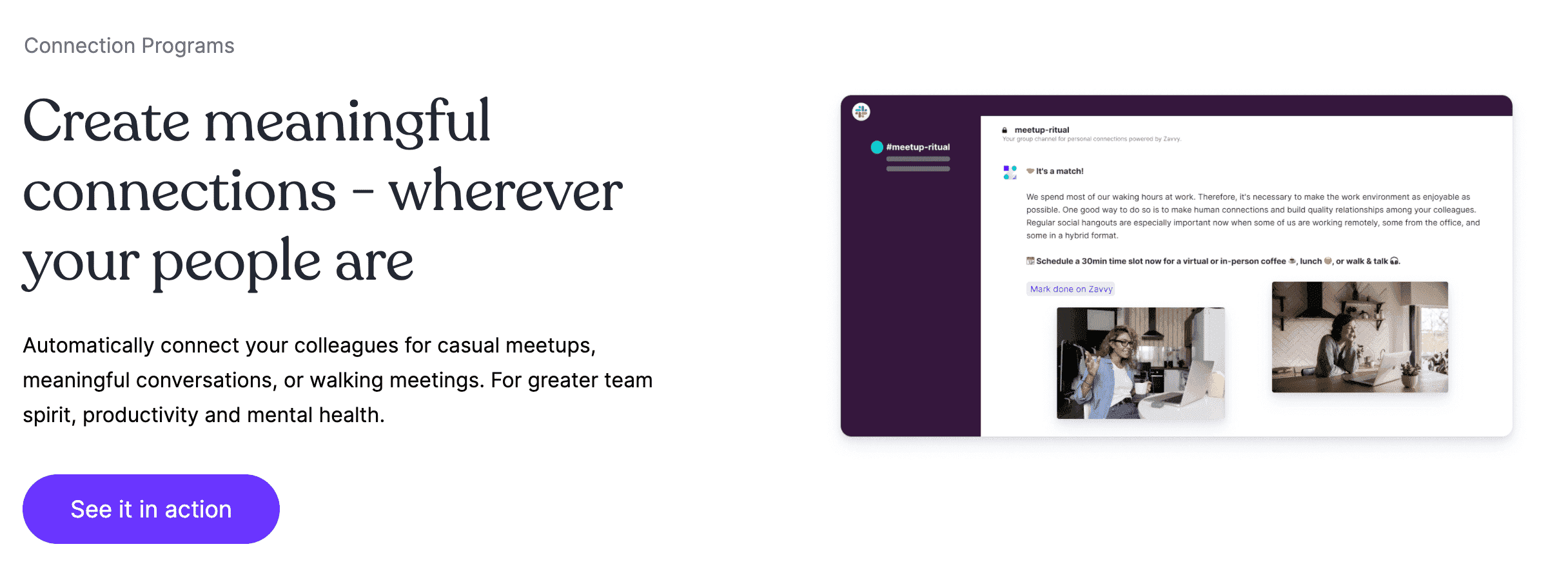
The meetings and Slack messages may not necessarily ensure that you know the new employee beyond work, and one way to do that is by catching up 1:1 on no-agenda meetings.
Similarly, you can set them up for casual calls or gaming sessions with their team members or people from other departments, too.
Little efforts like messaging them once in a while to check in if they're enjoying their time at the organization will go a long way in establishing a personal connection.
Serious stuff aside, let's talk about how to play around with tools and ideas to design an onboarding journey the newcomer will cherish for a lifetime. Here are some of our suggestions.
To make it more interesting, you can collect some questions from the team and share them as props. It can get as crazy as talking about which cartoon they loved the most when they were a child, their most memorable facepalm moment, their most loved hobby, or sharing what they wanted to be as a child.
It could be anything from a Yoga session or a truth and dare round to help the new joiner mingle with their new colleagues.
If there's one thing everyone badly misses in the remote work set up is those office lunch breaks, as they were a fantastic medium to get to know your colleagues effortlessly.
Nevertheless, we can replicate those lunch breaks over video calls where we may not get to taste what our colleague's mom made but can still enjoy the time together.
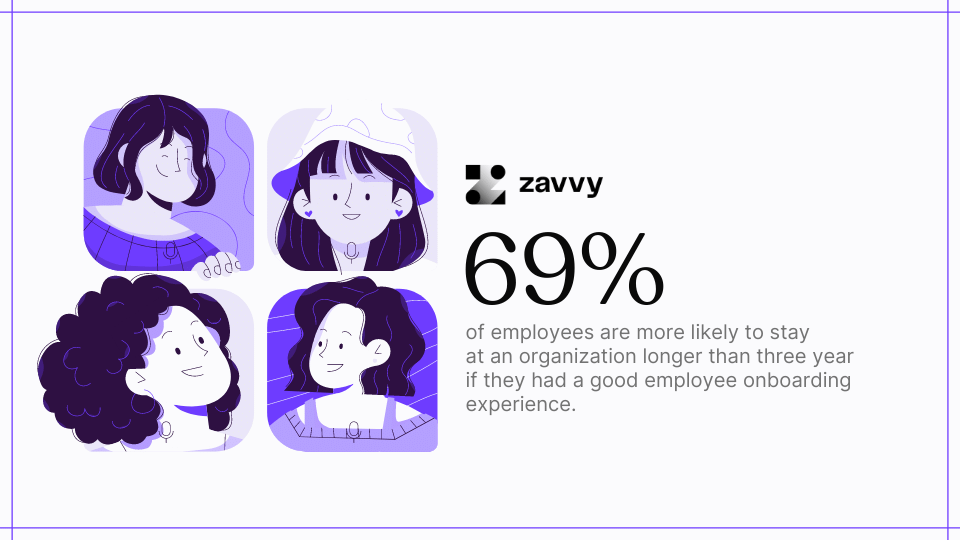
Usually, when someone says ice breakers, we think of interesting and funny questions that people ask.
You can retain the fun part but instead of asking questions to each other, create a welcome board. The board will have a fact or a hobby or a weird habit of the team members presented visually, and the new employee is supposed to identify the people to whom this information belongs to. It would make for a hilarious guessing game followed by the reactions of everyone watching it.
That's not all. Here are 17 more fun onboarding ideas for you to create a terrific onboarding experience for your new joiners.
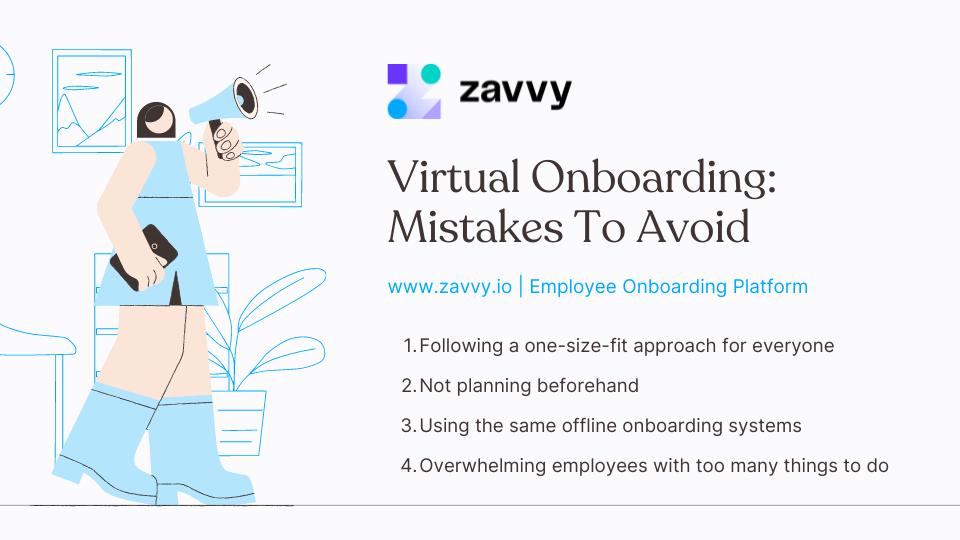
Just as two people cannot be similar, their capabilities and preferences differ.
This is why taking regular feedback on the onboarding matters. It'll help you address the loops that could be made more friendly and will give you an idea of what you need to change in the system for the next employee.
Planning day one or week one is not enough to get the employee fully rolling with their role and responsibilities.
While designing and automating your onboarding process, think long and have at least one month planned for the employee even before their joining date. To make it an extensive and fulfilling experience for them, make sure you provide enough resources, assistance, and collaboration needed at every step.
The world has taken a 180° turn since the onset of the pandemic, and the onboarding experience is no exception. It's not just the work setup that has changed from offline to online, but also there's a drastic evolution in how people communicate, collaborate, and structure their work. As a result, the 2019 approach has ceased to exist, and if you still apply the same method, it's time for a change.
It's no secret that usually, a new hire will get through humongous administrative tasks during onboarding.
The number could be daunting, but the process doesn't have to. You can break these tasks into smaller chunks and milestones to achieve. Don't forget to prioritize them based on how urgent and important they are.
This way, the employee will also have a structured day-to-day schedule and systematically complete their onboarding tasks.
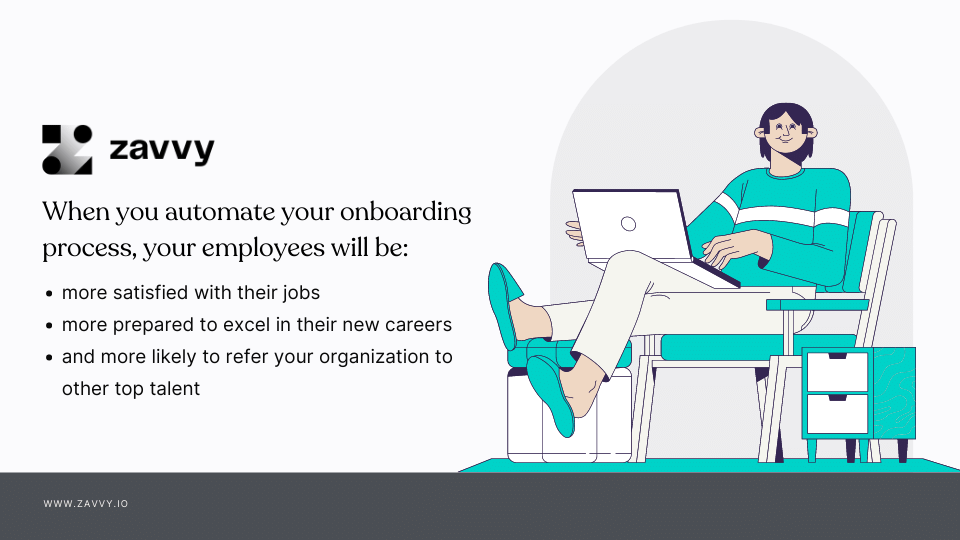
Automation takes over repetitive, unexciting, and monotonous tasks leaving you more room to be innovative in your job role.
The best part about it is that once you streamline all the aspects of your onboarding process, the automation will deliver the experience with better consistency than a human.
Zavvy's employee onboarding software is designed to help you deliver an exceptional and premium onboarding experience to your new employees without burning out your HR.
As the world keeps evolving, we understand that the systems that worked for HR managers in 2019 will no longer be relevant in 2022. That's why at Zavvy, we thrive on innovation and improvisation.
While working alongside this trajectory, we bring you an onboarding process that involves:
Remote work demands virtual onboarding. Although most of the elements have to be done online, it doesn't mean virtual onboarding doesn't have its perks.
Incorporate virtual activities, such as uploading a welcome video and gamification in learning, and leverage online collaboration tools. To maximize the impact, delegate the repetitive and mechanical actions to onboarding software, such as Zavvy, and use the precious time to build a personal interaction with the new hires.
Upskill your team every week with the best contents and personalized recommendations.

Your first impression is the last.
As much as this stands true for people, it applies to companies too.
Whether they launch a product or welcome new hires, the impression and impact should be top-notch.
Research from BambooHR revealed: 49 percent of employees who went through effective onboarding started contributing to their team within the first week.
And as we breathe and live everything online today, the need for a systematic and seamless virtual onboarding process elevates even further.
An ideal onboarding helps the employees kickstart their role and draws a clear vision for the next three days, three weeks, or three years they will spend with the organization.
The onboarding process intends nothing but to lay down a robust foundation for the relationship between the company and the employee. As a rule of thumb, the stronger the onboarding, the longer the relationship pans out.
However, since the pandemic's start, HR managers, recruiters, and founders are still having difficulties changing the gears from offline setup to online onboarding.
Get a demo!
We'll be happy to show you around and answer all your questions.
Trusted by innovative companies



We'll be happy to show you around, answer your questions, or arrange a free trial.
Erhalten Sie eine kostenlose Demo unserer Onboarding-Software.
Vertraut von



Your Training & Development Strategy - Solved in 1 Tool.
Trusted by innovative companies



We'll be happy to show you around, answer your questions, or arrange a free trial.
Learn how Zavvy helps you drive performance, development, and engagement.
Trusted by innovative companies



We'll be happy to show you around, answer your questions, or arrange a free trial.
We'll be happy to show you around and answer all your questions.
Trusted by innovative companies



We'll be happy to show you around, answer your questions, or arrange a free trial.
Gerne zeigen wir Ihnen ganz unverbindlich unsere Plattform im Detail.
Vertraut von modernen Unternehmen



Get a demo!
We'll be happy to show you around and answer all your questions.
Trusted by innovative companies



We'll be happy to show you around, answer your questions, or arrange a free trial.
Erhalten Sie eine kostenlose Demo unserer Software für Mitarbeiterenwicklung und Training.
Moderne Unternehmen
setzen auf Zavvy


